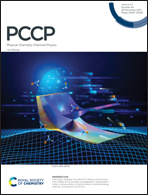Electronic properties of 2D and 1D carbon allotropes based on a triphenylene structural unit
Abstract
Several bottom-up chemical routes have been developed in the last few years to find ways to grow new forms of nanocarbon by devising a strategical selection of molecular precursors. Here, theoretical calculations are performed on 2D nanocarbon allotropes obtained from the fusion of triphenylene-like units through tetragonal rings. This 2D triphenylene structure has a metallic character in a closed shell configuration, but it also features a spin-polarized semiconducting state. The behavior of the electronic properties of the system is investigated when the structure is cast into nanoribbon forms. It is found that to be metallic in the nonpolarized case, the ribbons must be sufficiently wide while narrow 1D systems are semiconducting. A lower threshold width is also needed for the emergence of a spin-polarized semiconducting configuration in these nanoribbons. These behaviors are robust as they do not depend on edge geometry and chirality, thus offering opportunities for their possible applications in nanoscale devices.



 Please wait while we load your content...
Please wait while we load your content...